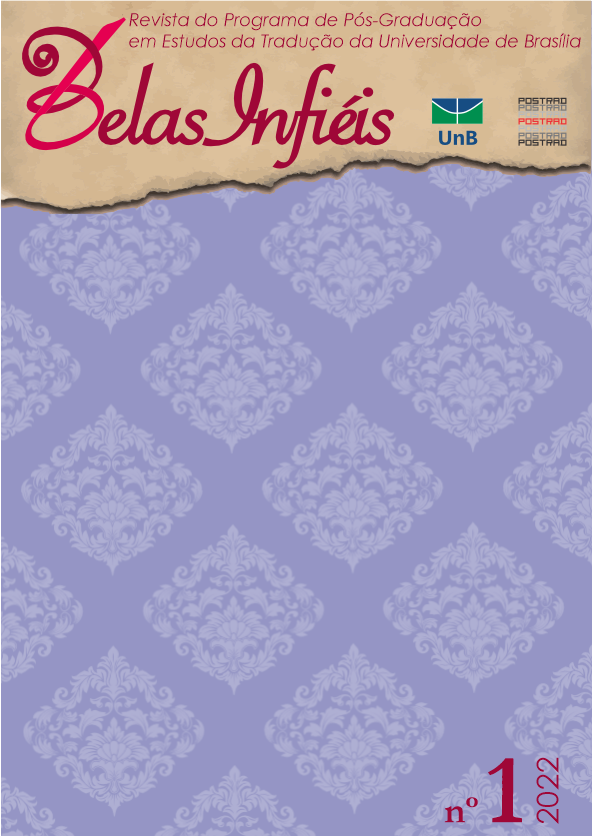Intralingual and interlingual translation of Pato do amor, a haiku in written Libras
DOI:
https://doi.org/10.26512/belasinfieis.v11.n1.2022.36003Keywords:
Sign Language Literature. Poetry in Libras/Portuguese. SignWriting. Interlingual Translation. Intralin-gual Translation.Abstract
This work analyzes the translation of a haiku from written Libras into Libras in video and into Portuguese. It seeks to answer the question: What features stand out when compensating for the poetry of the written form of sign language in its translation to video, and also into spoken language? Answers to this question can contribute to a better understanding of poetry in Libras, expand the possibilities of using sign language writing, and extend the concept of literary translation between Libras and Portuguese. We begin with the concept of translation as transcreation according to Campos (2015), and studies on Libras literature by Sutton-Spence (2021). We analyse Maurício Barreto's Pato do amor, a poem written in Libras. The analysis aims to classify the poem as a haiku, and understand the linguistic elements present in the poem. Then, we present and comment on two translations, one intralingual from written Libras into video Libras, which proved to be more than a simple reading and involved adaptations that highlight poetic possibilities of the recording; and one interlingual translation from written Libras into written Portuguese. We conclude that the poetic resources available in Libras can vary according to the mode of use of the language (written or oral). Video poetry further explored symmetry, morphism, and the repeated use of hand shapes. The translation into Portuguese revealed that typography and word choice worked together to benefit iconicity. In all translations, the selected features sought to make the version as visual as the original.
Downloads
References
Aguilar, G. (2005). Poesia Concreta Brasileira: as vanguardas na encruzilhada modernista. Editora da Universidade de São Paulo.
Albres, N. de A. (2020). Traduções comentadas de poesias em e traduzidas para línguas de sinais: um método de pesquisa em consolidação. Revista Araticum, 21(1), 70-90. https://www.periodicos.unimontes.br/index.php/araticum/article/view/2739
Barros, R. O. (2020). Tradução de poesia escrita em Libras para a língua portuguesa. [Dis-sertação de mestrado, Universidade Federal de Santa Catarina]. https://repositorio.ufsc.br/bitstream/handle/123456789/215945/PGET0475-D.pdf?sequence=-1
Barros, R. O. (2021). “Tradução de um haicai em Libras escrita para o português.” Univer-sidade Federal de Santa Catarina. Artigo não publicado. no prelo.
Barros, R. O.; Vieira, S. Z. (2020). The relationship between text and image in literary Pro-ductions in Libras. Sign Language Studies, 20(3), 392-410. https://muse.jhu.edu/article/756288
Campos, H. de. (2001). Entrevista concedida a Armando Sergio Prazeres, Irene Machado e Yvana Fechine. Revista Galáxia, (1), 25-47. http://docplayer.com.br/19047506-Galaxia-n-1-2001-casa-de-mallarme-valvins-1994-foto-carmen-de-arruda-campos.html
Campos, H. de. (2015). Da tradução como criação e como crítica. In: Tápia, M.; Nóbrega, T. M (orgs.). Haroldo de Campos - transcriação (pp. 1 - 19). Perspectiva.
Cuxac, C.; Sallandre, A. (2007). Iconicity and arbitrariness in French Sign Language: highly iconic structures, degenerated iconity and diagrammatic iconicity. In: Pizzuto, E.; Pietrandrea, P.; Simone, R.. Verbal and signed languages (pp. 15 - 30). Mouton de Gruyter https://hal.archives-ouvertes.fr/tel-01336182/file/HDR_Sallandre-M.A_2014_volume2_Travaux%26Publications.pdf
Ferreira, J. G. D. (2019). Os Intérpretes Surdos e o Processo Interpretativo Interlíngue In-tramodal Gestual-visual da ASL para Libras. [Dissertação de mestrado, Universida-de Federal de Santa Catarina] https://repositorio.ufsc.br/handle/123456789/214607
Franchetti, P. (2008). O haicai no Brasil. Alea, 10(2), 256-269. https://www.scielo.br/pdf/alea/v10n2/07.pdf
Hirashima, C. K. (2007). O haikau nas artes visuais: tradução intersemiótica. 2007. [Dis-sertação de Mestrado, Universidade de São Paulo] https://teses.usp.br/teses/disponiveis/27/27131/tde-21072009-202225/publico/5062750.pdf
Jakobson, R. (2010). Linguística e Comunicação. Cultrix.
Kaneko, M. (2008). The Poetics of Sign Language Haiku [Manuscrito não publicado]. Uni-versity of Bristol.
Klamt, M. M. (2018). Sonoridade visual na sinalização artística em língua brasileira de si-nais. [Tese de doutorado, Universidade Federal de Santa Catarina] https://repositorio.ufsc.br/bitstream/handle/123456789/190161/PLLG0716-T.pdf?sequence=-1&isAllowed=y
Klima, E. S.; Bellugi, U. (1979). Poetry and Song in a Language without Sound. In: Klima, E. S.; Bellugi, U. (orgs.). The signs of language (pp. 340 - 374). Harward Press.
Lira, J. (2010). O jogo da tradução nos limites do haicai. Scientia Traductiones, (7), 180-189. https://periodicos.ufsc.br/index.php/scientia/article/view/1980-4237.2010n7p180/12868.
Machado, F. A. (2014). Simetria: poética em língua de sinais. In: Stumpf, M. R.; Leite, T. A.; Quadros, R. M. (Orgs.). Estudos da Língua Brasileira de Sinais II (pp. 229-244). Editora Insular. http://procadamazonia.epizy.com/wavesviewer/?id=123456789/178900&i=1
Marcuschi, L. A. (1997). Oralidade e escrita. Signótica, (9), 119-145. https://revistas.ufg.br/sig/article/view/7396/5262.
Oliveira, A. M. A. dos S. (2007). Entre o verbal e o visual: o haikai e a fotografia na poética de Paulo Leminski. A cor das letras, (8), 117-130. http://periodicos.uefs.br/index.php/acordasletras/article/download/1570/pdf
Prodanov, C. C.; Freitas, E. C. de. (2013). Metodologia do trabalho científico [recurso ele-trônico]: métodos e técnicas da pesquisa e do trabalho acadêmico. Feevale.
Spiekermann, E. (2011). A linguagem invisível da tipografia: escolher, combinar e expres-sar com tipos. Blucher.
Souza, S. X. (2009). Traduzibilidade poética na interface libras-português: aspectos linguís-ticos e tradutórios com base em Bandeira Brasileira de Pimenta (1999). In: Quadros, R. M.; Stumpf, M. R. (Org.). Estudos Surdos IV (pp. 310-352). Editora Arara Azul. http://editora-arara-azul.com.br/site/ebook/detalhes/14.
Sutton-Spence, Rachel. (2021). Literatura em Libras. Editora Arara Azul.
Torres, M.-H. C.(2017). Por que e como pesquisar tradução comentada? In: Freitas,L. F.; Torres, M.-H.; Costa, W. C. Literatura Traduzida: tradução comentada e comentários de tradução (pp. 15-36. Substânsia. https://repositorio.ufsc.br/bitstream/handle/123456789/181534/Literatura%20traduzida.pdf?sequence=1&isAllowed=y
Downloads
Published
How to Cite
Issue
Section
License
Copyright (c) 2022 CC BY

This work is licensed under a Creative Commons Attribution 4.0 International License.
Given the public access to this journal, the texts are free to use but requires the recognition of the original authorship and initial publication in this journal to be properly stated.
 The journal allows the use of works published for non-commercial purposes, including the right to submit the work to publicly accessible databases. Published contributions are the sole and exclusive responsibility of the author(s).Â



















